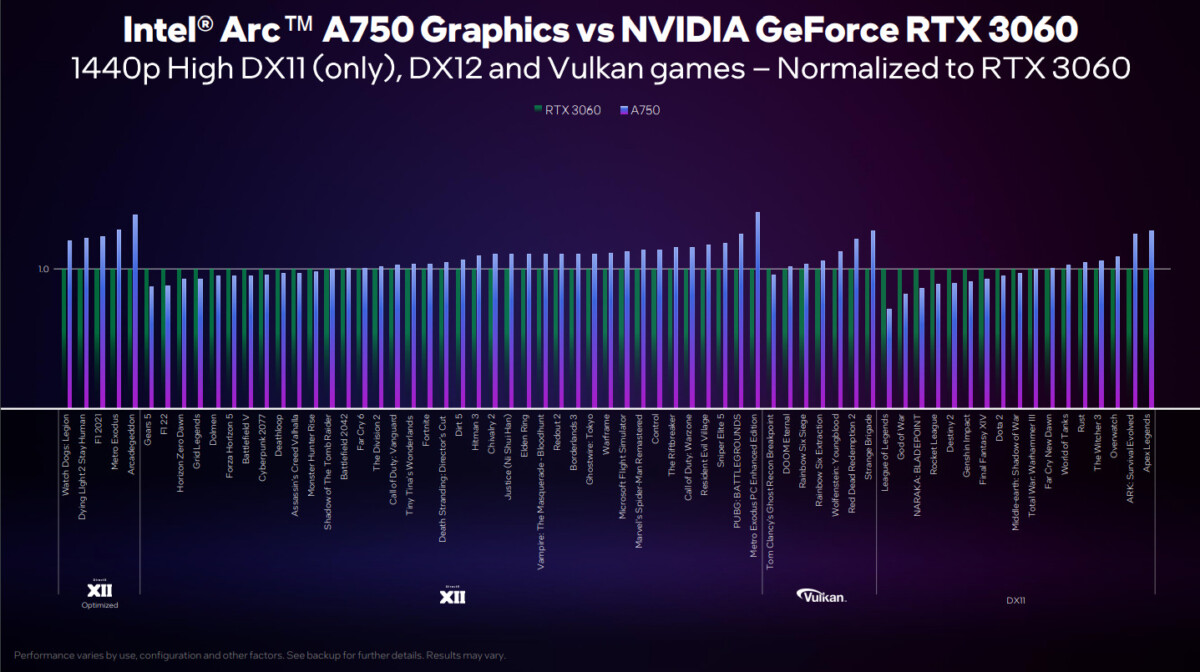Having more information on Intel Arc graphics cards is worth it. After months of waiting, and with their full-scale launch fast approaching, Intel is finally revealing the full specs of its Arc A770 and A750, along with a price for the Arc A750.
Expected on October 12, the now imminent launch of the Arc A770 and A750 is prompting Intel to fully reveal the technical characteristics of its new graphics cards, but also (slightly) more precise clues as to the performance they will develop. The price of the A750 is also fixed, with a positioning at 289 dollars planned across the Atlantic.
This announcement comes a few days after Intel specified the price of its Arc A770, announced from 329 dollars. The firm however specifies today that its A770 will in fact be available in two distinct versions: the basic model, announced at 329 dollars and equipped with 8 GB of GDDR6, and a “Limited Edition” with 16 GB of GDDR6 and slightly increased memory bandwidth, for $349.
Fuzzy comparisons with the RTX 3060… and an overlooked RTX 3060 Ti
Anyway, the Intel Arc A770 and A750 both want to compete with the RTX 3060… a card that is no longer very fresh. As ArsTechnica rightly points out, its launch now dates back 18 months. Intel’s chips will therefore quickly be left behind in terms of pure performance, since Nvidia should launch an RTX 4060 at the start of 2023. The technical characteristics of the two new Intel GPUs are nevertheless clearly listed in the tables below. -below.
Source: Intel via ArsTechnica
In the meantime, to confront its new cards with Nvidia’s mid-range chip, Intel is implementing a “performance per dollar” measure that is not always very convincing. Above all, it seems to allow the brand to avoid a frank comparison, with supporting percentages, or too direct a confrontation on the frame rate displayed by its cards against a still-vivacious RTX 3060. In its comparison table between the Arc A750 8 GB and an RTX 3060 12 GB EVGA, the Intel chip thus appears in a rather flattering light.
Continuing with this somewhat vague performance/price ratio rhetoric, Intel assures that its “basic” Arc A770 would make it possible to obtain 42% more performance per dollar, on average, than an RTX 3060 sold at 418 dollars (in average there too). Same dynamic according to Intel for the Arc A750, which would offer 53% more performance per dollar than the same RTX 3060.

Source: Intel via ArsTechnica
As ArsTechnica reports, it looks like Intel is bogged down with this “performance per dollar” system when it comes to comparing its cards to the RTX 3060 Ti – whose prices are more volatile. As it stands, the firm therefore prefers to act as if the RTX 3060 Ti did not exist. ” The prices for the 3060 Ti are just crazy, so we didn’t want to include it in our analysis. “, Thus specified Tom Petersen, an executive of the graphics division of Intel interviewed by the press.
Clearly, and as often, only independent tests will therefore make it possible to know what the Arc A770 and A750 are really worth compared to their competitors. Intel, on the other hand, admitted half-heartedly that its cards are less comfortable with DirectX 11 than Nvidia’s cards, which should penalize them in older titles still based on this version of Microsoft’s API.
Intel leaves it up to its partners to make their own announcements
Last point, just as important: the question of the availability of the Arc A770 and A750. On this side too, Intel is also a little evasive. The firm recognizes that the volumes of Arc A770 Limited Edition (equipped with 16 GB of VRAM) will be low… and that the availability of this model will probably be limited. “We don’t know if we’re going to have a supply problem or a demand problem. I hope we will have a request problemcontinued Tom Petersen about the “classic” Arc A770 and A750 models.
Intel has however indicated that it plans to produce its GPUs internally in the future (they are currently in production at TSMC), which should help reduce the risk of shortages in the event of high demand. The firm remains discreet on the other hand on the AIB (EVGA, MSI, Zotac, Sapphire, Asus, Gigabyte, Gainward…). It is therefore unknown which partners Intel will rely on for the launch of the models.customsof its cards in October. In this regard, Intel is content for the moment to indicate that the AIB manufacturers will make their announcements themselves, later.
To follow us, we invite you to download our Android and iOS application. You can read our articles, files, and watch our latest YouTube videos.
